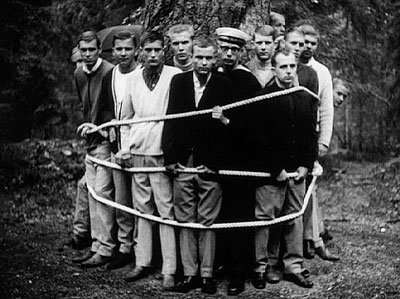Mann, Thomas. “Death in Venice.” Death in Venice and Seven Other Stories (1911). H.T. Lowe-Porter, trans. New York: Vintage, 1954.
 A novella of man-boy love and a disease that starts to mysteriously kill unsuspecting people, if that’s not redundant. One can’t help in reading the story but think of AIDS, particularly in the way Mann describes the attempts of the state to cover up the illness (cholera, in this instance): “[T]he fears of the people supported the persistant policy of silence and denial. The city’s first medical officer [. . .] had indignantly resigned his office and been privily replaced by a more competant person.”
A novella of man-boy love and a disease that starts to mysteriously kill unsuspecting people, if that’s not redundant. One can’t help in reading the story but think of AIDS, particularly in the way Mann describes the attempts of the state to cover up the illness (cholera, in this instance): “[T]he fears of the people supported the persistant policy of silence and denial. The city’s first medical officer [. . .] had indignantly resigned his office and been privily replaced by a more competant person.”Gustave Aschenbach, the hero of the story who falls in self-surprised love with the young Polish boy Tadzio, is an author and widower who finds himself in Venice after a spell of wanderlust brought on by the face of a stranger in the street. Mann takes much time and care building up this guy’s credentials—he’s not just a writer, but a noteworthy writer, an author, really, whose work has inspired those who’ve come after him. Indeed, he’s created a new kind of literary hero, described as “[t]he conception of an intellectual and virginial manliness, which clenches its teeth and stands in modest defiance of the swords and spears that pierce its side” (11). Mann’s narrator continues:
That was beautiful [. . .] it was exact, despite the suggestion of too great passivity it held. Forbearance in the fact of fate, beauty constant under torture, are not merely passive. They are a positive achievement, an explicit triumph; and the figure of Sebastian is the most beautiful symbol, if not of art as a whole, yet certainly of the art we speak of here. (11)Saint Sebastian—all tied up and flayed with arrows—has for a long time been a symbol of homosexual beauty and adjunctery, or maybe it’s just a matter of him being our unofficial patron saint. For a long time I thought this was kind of gross. I thought it had to do with eroticism (he’s always painted wearing little more than a loincloth, sometimes even nude) and the glorification of suffering. But I like here how Mann reads Sebastian and finds strength and heroism in the traditionally “passive” protagonist. Forbearance as something that one achieves, rather than some default one falls back on. This is very much along the same lines of what Kushner describes in Angels in America.


0 Comments:
Post a Comment
<< Home